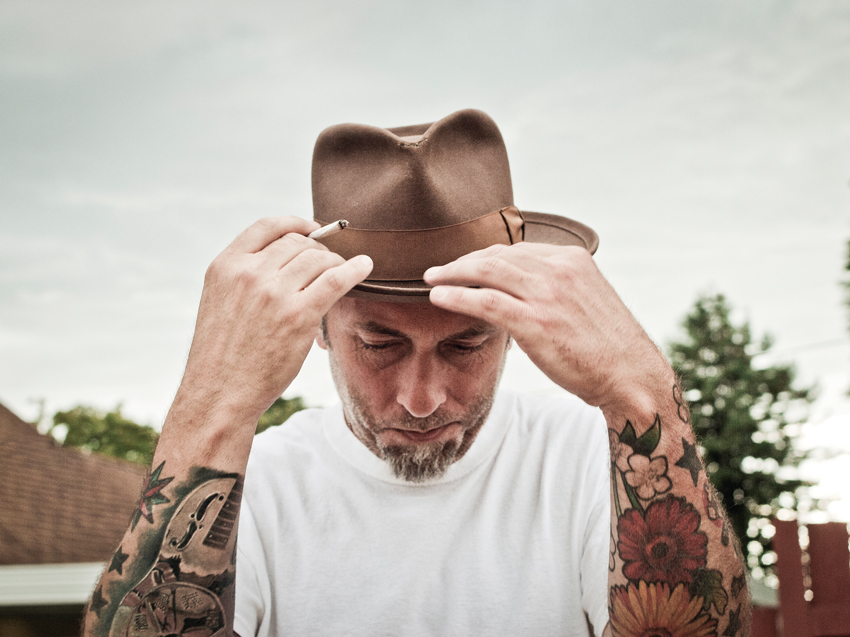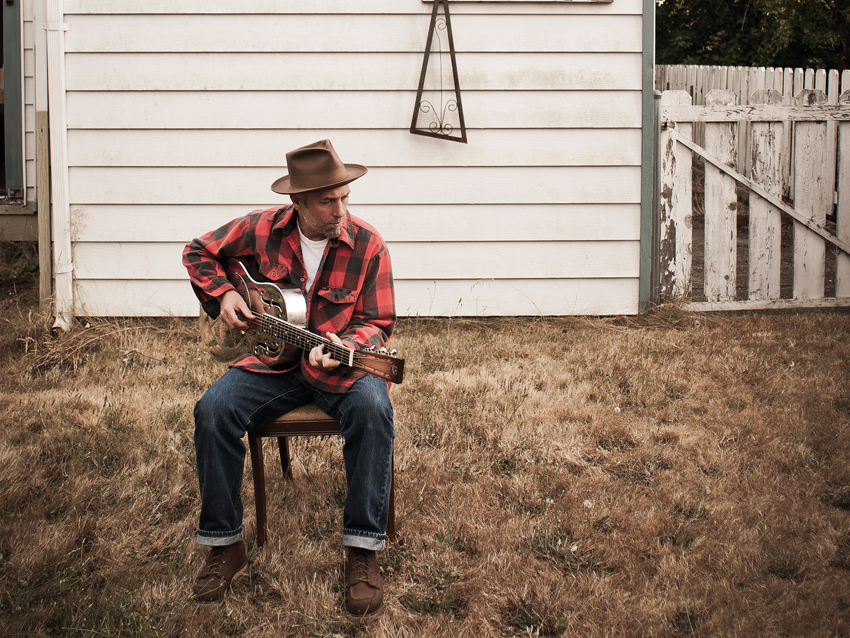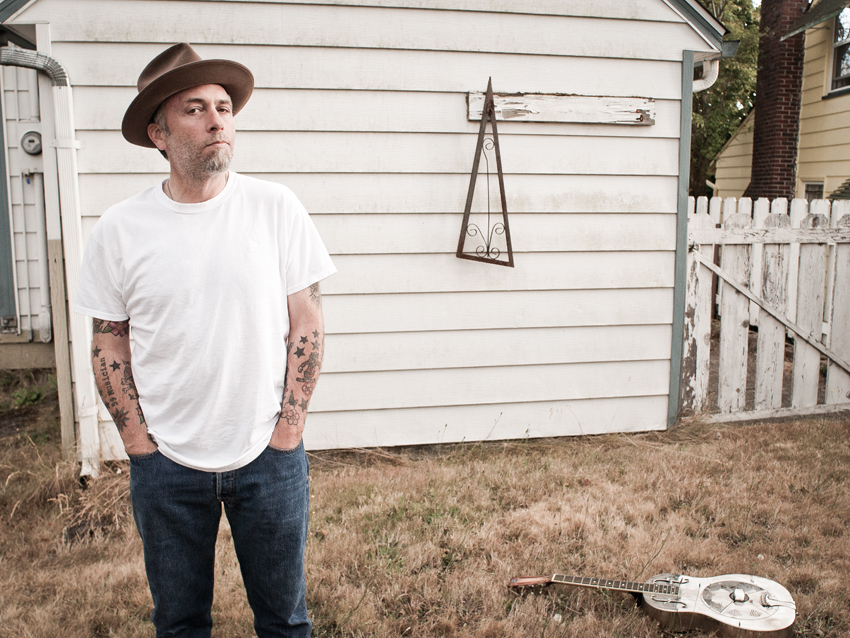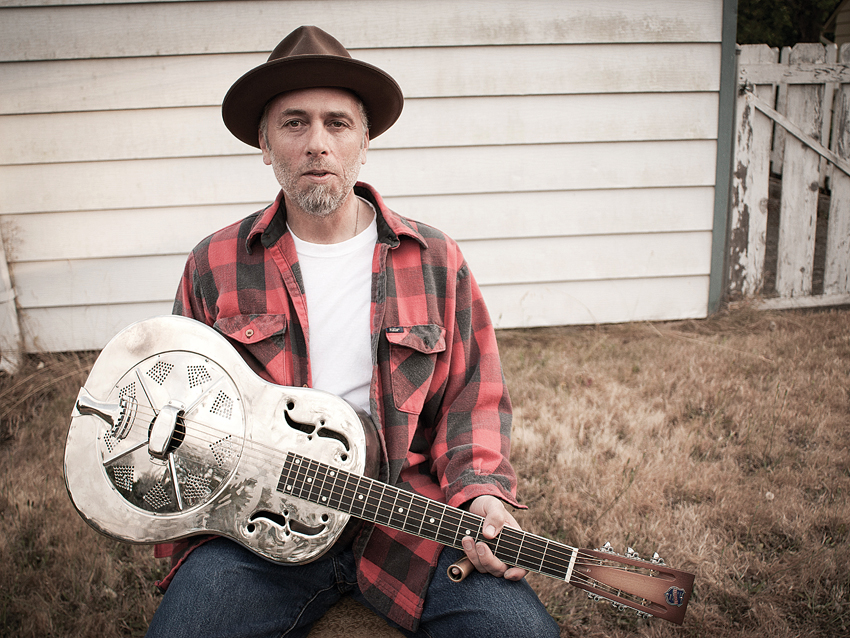Kelly Joe Phelps on slide guitar
We talk mastering the sound of slide

Kelly Joe Phelps on slide guitar
There aren’t many musicians who end up at acoustic blues- based guitar after a decade immersed in ‘free jazz’... mostly playing bass.
It’s just part of the enigma that is Kelly Joe Phelps, supremely talented slide and fingerstyle player, gifted vocalist and assured songwriter who marks his 20th year as
a solo recording artist in 2014.
Born in Portland, Oregon and raised in Sumner, Washington, Phelps’ music listening always took in “rural music” as he describes it – blues, country and gospel – a mix of genres that have come to underpin his own unique approach to playing and writing. We took the chance to catch up with him, to talk specifically about his approach to slide guitar.
You had to stop playing last year because of a nerve affliction in your right arm. How are you now?
“Everything’s fine – I still don’t know exactly what happened, or why it happened, but I’ve been touring again since this past September, and everything’s been completely fine. No issues, no problems whatsoever, so I don’t know what that was all about, other than maybe it was time for my body to take a break. I was off for about seven months, I think.
“It certainly did give me time for reflection in terms of music because there was some point in there where I didn’t know what was happening with my arm and having to wonder if maybe my playing days were over. I’ve been playing guitar for 40-odd years, so I’d never not played the guitar for so long. But September rolled around, and I jumped back out on tour with my fingers crossed, and everything was fine. So that was very strange, and I came out of it extremely grateful for the gift of music.”

Slide roots
What first turned you on to slide?
“Well, I didn’t listen to that stuff until later than you would expect. I was 12 or 13 years old when I started playing guitar and I didn’t pay attention to slide guitar and all that stuff until I was about 30 years old. So I’d been playing guitar for nearly 20 years before I gave slide guitar playing some real attention.
“By the time I got into my late teens, I was already immersing myself in jazz music, so I didn’t really pay a lot of attention to slide guitar music. And the first thing that I remember listening to was all that Robert Johnson stuff, but in terms of hearing something that made me want to play slide guitar, almost all the credit goes to [Mississippi] Fred McDowell.
"There was something about his playing that touched me in a very deep place. I still don’t understand what that place is, necessarily. The sound of the slide guitar opened up for me and I could, in terms of a kind of vision, see how I might be able to do it.”
What are the pros and cons of lap-style playing as opposed to upright, bottleneck slide? You’ve done both...
“I feel like the lap style has more restrictions inherent in it. The main problem with lap style is simply because the player can’t fret any notes at all, so every single note that’s played with lap style is either going to be an open string, or it’s going to be a string played with a slide bar.
“It is a great sound, and I had a lot of fun doing it when I was doing that, and felt creative with it and everything. So I don’t have any issues that way, but at some point I thought, ‘Wow, man, there’s really going to be a limit to this. There are only so many notes.’ And because you’re essentially handcuffed by not being able to fret anything, you’re stuck just trying different tunings and playing just a few songs.
“So I saw that as a limit, and more and more I saw it as frustrating. And that’s not to say there aren’t similar things about bottleneck playing, but it is very freeing to be able to fret things, to change chord voicings or fret notes behind the slide while holding the slide on the strings. And because the player can fret things with or without the slide, you can go from minor to major tonalities just by pressing a finger down, so there’s a lot more colour and variation available.
“Another thing I like about it, too, is that there are fewer slide notes, so they have a chance to stand out more. It gives me a chance to really bring out the sense that the slide notes are the melody notes – they’re being sung. So it feels to me like there are enough options with bottleneck that, while it may not be an infinite study, it’s going to be a longer one.”

Tunings, picking and guitars

Beginner tips
What kind of slides do you use?
“I use a brass slide: it’s the same slide that Leo Kottke has used for years. It’s by a funny machine [manufacturing] company that happen to make guitar slides, called Latch Lake. They’re slightly hourglass-shaped, which is cool because it compensates for the difference in the string gauges, from the low ones to the high ones. There’s a little bit of radius on the strings from low to high, so it compensates for that as well.
“It’s nice, because once I got used to that particular slide I realised one of the great advantages to it was I didn’t have to press as hard with the thing – you can use a very light touch with it. Because it’s kind of taking care of all the curves and angles.”
You’re one of the best slide players out there – what are your tips for raw beginners in the style?
“Oh boy. It’s hard to say one thing, but the obvious thing is always going to be, please, be patient with yourself. Maybe one other thing that comes to mind – and I don’t know if I’ve even thought about this before – I would think it would be wise for someone who does play guitar already to, when they start playing slide, just play single-note melodies. Just to get used to moving the slide around. Because along with the damping issues, you’ve also got potential intonation problems with the slide.
“So it might be good for a person to get comfortable with just playing the melody lines and not try to do the fingerstyle stuff, or even worry about that too much. Just try to pull straight melody lines out: you’re going to want to mute the strings on either side, so if you’re playing a melody on the third string, the second string and the fourth string are going to be the ones to keep an eye on in terms of muting.”
What’s next for you?
“I’m going to be touring in the UK in probably mid-September this year – but, before then, I’m going to be going across the Eastern US, through Canada. In April, I go to Iceland for about 10 days, and then from there to Europe for about four weeks. I’ve recently discussed the possibility of making another recording some time this summer, but I don’t have any material yet, so that may or may not happen. But I scheduled it in a while back just to give me the needed pressure to get some work done!”

Jamie Dickson is Editor-in-Chief of Guitarist magazine, Britain's best-selling and longest-running monthly for guitar players. He started his career at the Daily Telegraph in London, where his first assignment was interviewing blue-eyed soul legend Robert Palmer, going on to become a full-time author on music, writing for benchmark references such as 1001 Albums You Must Hear Before You Die and Dorling Kindersley's How To Play Guitar Step By Step. He joined Guitarist in 2011 and since then it has been his privilege to interview everyone from B.B. King to St. Vincent for Guitarist's readers, while sharing insights into scores of historic guitars, from Rory Gallagher's '61 Strat to the first Martin D-28 ever made.
“For those on the hunt for a great quality 12-string electro-acoustic that won’t break the bank, it's a no-brainer”: Martin X Series Remastered D-X2E Brazilian 12-String review
“Beyond its beauty, the cocobolo contributes to the guitar’s overall projection and sustain”: Cort’s stunning new Gold Series acoustic is a love letter to an exotic tone wood
“For those on the hunt for a great quality 12-string electro-acoustic that won’t break the bank, it's a no-brainer”: Martin X Series Remastered D-X2E Brazilian 12-String review
“Beyond its beauty, the cocobolo contributes to the guitar’s overall projection and sustain”: Cort’s stunning new Gold Series acoustic is a love letter to an exotic tone wood











